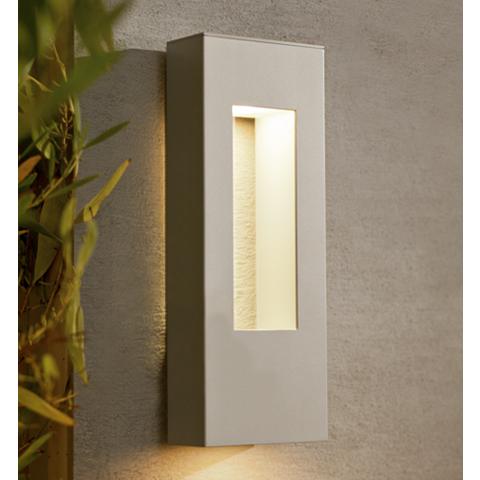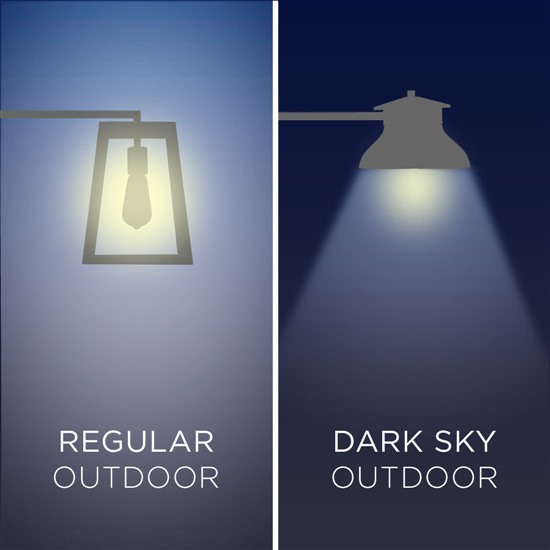Questions With: International Dark Sky Association, Part 2

Learn more about Dark Sky lighting, including what mistakes to avoid when selecting a Dark Sky rated design.
In addition to that topic, part 2 of our conversation with policy research Intern James Hanna from the International Dark Sky Association focuses on other Dark Sky lighting issues of interest to homeowners.

Q: What qualifies as a Dark Sky residential outdoor fixture?
A: Essentially a dark sky friendly outdoor residential fixture is one that is also “good neighbor” friendly. Good neighbor friendly fixtures aim to reduce intrusive light on a neighbor’s property by limiting light pollution sources such as glare, light trespass, and skyglow.
Many people feel that just because a fixture is under an eave or porch, the fixture is automatically dark sky friendly because it doesn’t shine any light up.
Well, these fixtures can, and often are, the worst offenders when it comes to good neighbor lighting practices since they almost certainly cause glare and trespass.
Residential lighting should be shielded, so that the light source cannot be seen, low luminance levels (low light output), and use an energy efficient bulb. Also, the light should only be used to illuminate the necessary area.
That’s not to say that you shouldn’t have landscape lighting or architectural lighting, but consider placing these light sources on timers or motion sensor, so that late at night when no one needs the light to see, the lights are turned off.
In addition, IDA recommends including a porch light/door light that properly allows the resident to view and identify a visitor through a peephole.
If this cannot be accomplished with a fully shielded fixture, we recommend a low level semi-translucent luminaire face with a lamp output of under 1000 lumens (approximately 60 Watts Incandescent and 13-15 Watts Compact Fluorescent). IDA has a Good Neighbor Lighting concept practical guide (opens in PDF form) with more information.

Q: For the typical home owner, what are some of the common mistakes made when lighting their property?
A: The most prevalent mistake made by home owners is the over lighting of their property.
This can be due to a desire for a particular aesthetic appeal, or the perceived need for security.
In actuality, though, a more controlled, less intense and evenly illuminated light scheme, can actually fulfill both of these desires. This is truly one where less is really more.
First, light of a carefully directed (preferably downward) nature can better show off the architectural style and structure of a home in order to play up particularly appealing aspects, and downplay others that may be less so.
Second, greater amounts of light does not mean greater amounts of security, it often simply provides the feeling of it.
Well placed, downward aimed lighting of a minimal nature can easily illuminate pathways, and doorways, as well as landscapes in a way that does not wash out details, induce glare,or leave dark zones on the perimeters of lighted areas.
Combined, these techniques may make it easier to spot a security threat or obstacle than in a brightly floodlit area.
In addition, the use of motion detectors supplies an additional layer of security as the lights draw attention to an otherwise dark area.
Furthermore these controlled lighting schemes are less invasive towards neighbors, who one aims to impress with their tasteful and considerate lighting as well as relies upon to keep watch of a property from the exterior.
Q: What recommendations do you have for home owners to lessen their impact on the nighttime skies?
A: The simplest way a homeowner can lessen their impact upon the nighttime skies is to turn off all unnecessary lighting at night. Next a homeowner can choose to replace high wattage, overly bright light bulbs, with those of a more efficient and application appropriate nature.
Ideally though, a homeowner can decided to make the maximum positive impact upon the nighttime environment by replacing or retrofitting all existing outdoor fixtures with either lighting covers, or dark sky friendly fixtures, both of which control light in a way that reduces glare, light trespass, and skyglow.
Q: Are there any considerations with “aging eye” older home owners and Dark Sky lighting?
A: The considerations that must be made for the aging eyes of older homeowners are actually well addressed by dark sky friendly lighting fixtures. As the human eye ages it becomes far more sensitive to bright light and takes more time to adapt between light and dark conditions.
So, existing floodlighting on a homes’ exterior, as well as other overly bright and glaring lighting, can actually make it harder for an elderly individual to discern obstacles and other features of the outdoor environment at night.
Thereby, the implementation of lower wattage, less intense lighting, and shielded fixtures will in fact make it far easier for these home owners to observe their property safely and accurately at night.
Q: How can Dark Sky lighting and home security work together?
A: As mentioned above, dark sky lighting can actually allow properties to be more secure than they would be with many traditional forms of lighting.
The more directed, accurate, and less invasive light, that is cast by dark sky friendly fixtures illuminates only what needs to be, allowing for the quick discernment of threats through a lack of glare and heavy shadowing at the perimeter of overly lit areas.
Thanks to James and all at the International Dark Sky Association for their input! Let us know if you have any questions or feedback.
More Dark Sky Lighting Ideas and Advice
Questions With the International Dark Sky Association Part 1
3 Easy Ways to Dark Sky Lighting
A Guide to Dark Sky Outdoor Lighting – 6 Quick Tips
